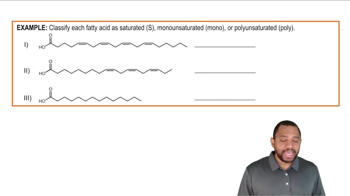How many molecules of acetyl-CoA are produced by catabolism of the following fatty acids, and how many β oxidations are needed?
a. Palmitic acid, CH3(CH2)14COOH
 Verified step by step guidance
Verified step by step guidance Verified video answer for a similar problem:
Verified video answer for a similar problem:



 1:29m
1:29mMaster Oxidation of Fatty Acids Concept 1 with a bite sized video explanation from Jules
Start learning